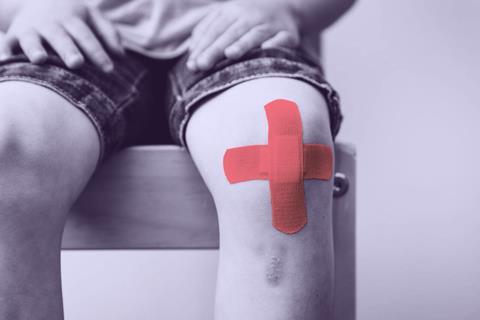Sally Hope believes that of all people, Christians should be engaged with those in society who have had a lousy start

Within the health and social care sector, research on the lifelong effects of adverse childhood experiences, and their prevalence within the general population, has led to a renewed focus on the benefits of good early attachments and trauma informed practice. Schools, youth workers and parents are being encouraged to learn and understand about how childhood experiences affect brain development, what can be done to protect against any negative effects and how we can raise and work with children in a way that promotes healing from traumatic and adverse events. Yet, despite the new language, the renewed focus and the government funded projects, none of this information should be news to Christians, because Jesus advocated for good attachments and trauma informed practice over 2000 years ago, he just used a different word for it: love.
What are ‘adverse childhood experiences’ and why are they suddenly something we should be thinking about?
Adverse Childhood Experiences (or ACEs) are stressful or traumatic experiences that breach a young person’s safety, security, or bodily integrity. They may be a single event, or a series of recurring events caused by the situation the child lives in. They include things such as
- Physical, sexual, or emotional abuse
- Physical or emotional neglect
- Living with someone who abused drugs or alcohol.
- Exposure to domestic violence
- Living with someone who has gone to prison.
- Living with someone with serious mental illness
- Losing a parent through divorce, death, or abandonment
The original study of ACEs was carried out in 1998 by Vincent Felitti. It found that adults who had experienced these adversities as children were at increased risk of early death from factors such as heart or liver disease. It also found that they were more likely to smoke, use drugs, be obese and have poor academic performance. Since this time a large body of evidence has consistently shown that those who experience ACEs are more likely to have poorer outcomes across a variety of measures, including mental health and emotional regulation. The more ACEs a person has, the higher the risk. ACEs can have a detrimental effect on every aspect of a person’s life and can even cause physical changes to the brain.
Research in 2014* found that nearly half (47%) of those surveyed had experienced at least one adverse childhood experience and around 10% had experienced two or more. This means that it is not only those children being looked after by social services who are likely to have been affected, but up to half of the children in our schools, our youth groups, and our Sunday Schools. In many cases we will be unaware of that trauma, and those children will be more at risk of facing disadvantages as they grow up. In fact, 85% of those who face multiple disadvantages in society as adults have experienced trauma as children. ** This is why many proponents of trauma informed practice believe that we should become a “trauma informed society.” If we look at what it means to be “trauma informed” this is precisely the compassionate model for society that Jesus advocated.
What does it have to do with attachment?
Whilst adverse childhood experiences can have a detrimental effect on future prospects, we have also learned that forming healthy attachments has a positive effect on children’s future well-being. In fact, epidemiologist Dr Linda Burgess Chamberlain claims that “healthy relationships are the most important experience your child can have.” *** Attachment Theory**** tells us that a child needs to form attachments to caregivers, not only for their physical survival, but also in order for their brains to fully develop, some psychologists have even claimed that a sense of belonging is as much an essential human need as food and water.
Neuroscience informs us that the reason for this is that the brain develops by forming neural connections. When a child experiences positive attachments they form connections which lead to a sense of safety and security. This safe base provides the security a child needs to explore the world around them to develop good cognitive skills. A brain that is experiencing trauma becomes “stuck” in “survival mode” and is unable to fully develop and form healthy connections. Instead, when we experience trauma, we learn that the world is an inherently unsafe place and that other humans are a source of danger. Our brain creates physical pathways that cause our bodies to be more prone to stress reactions. When we understand Adverse Childhood Experiences in light of attachment, we see that good, safe and secure relationships are a “protective factor” that can mitigate the negative effects of trauma.
Protective factors.
Protective factors are aspects of a child’s life that decrease the likelihood of them experiencing ACEs in the first place and that reduce the effect of those stressors if they do arise. Protective factors such as parental resilience, parental knowledge of child development and good support networks for parents, increase parents’ ability to manage conflict and to protect their children. Therefore, they reduce a child’s risk of experiencing ACEs in the first place. Protective factors such as nurturing and attachments, good social and emotional development and healthy social connections increase a child’s resilience to adversity and lessen the impact of stress and trauma. We know that Children need “consistent, supportive, and loving” adults who create resilient environments (Futures Without Violence, 2013; Masten, 2009). The more loving adults we can fill a child’s life with, the more resilient they are likely to become. This is where the Church comes in.
Trauma Informed Society
Science has provided us with an understanding of the effects of trauma on our bodies and mind; we know that trauma physically affects brain development. The good news is that science also tells us that these effects can be reversed. Brain mapping technology shows us that our brain has a remarkable ability to heal, that at any point in our lives it can re-wire itself, breaking down old, unhealthy connections and forming new ones. So, whilst children who have experienced trauma often do experience worse outcomes than those who have not, it doesn’t have to be this way.
This is why “trauma informed practice” has become such a buzzword in recovery and early intervention prevention work. Professionals seek to find ways of interacting with children that build a child’s resilience and provide the safety and security that children who have experienced trauma need to heal. Although there is no one single model for trauma informed practice there are five guiding principles that parents and practitioners should seek to employ in their relationships with children if they wish to encourage resilience and healing:
- Recognise and respond to trauma. Be aware of the different forms of trauma children could have experienced, understand the impact this could have on a child’s behaviour and be sensitive to the fact that “problematic behaviours” may be a reaction to an adverse experience.
- Provide safe environments. Not only physically safe, but emotionally and spiritually too. Be aware that different children may have different needs to make them feel safe and empower children to be involved in creating safe environments.
- Build the child’s strengths. Focus on what the child is good at and encourage them to solve their own problems. Encourage independence.
- Build empowering relationships. Many trauma situations involve an abuse of power. As a result, relationships where there is a power imbalance can become frightening. Healthy relationships with adults, even professional relationships, help to provide the connection and attachment that survivors need to re-wire their neurology.
- Promote Equality of Access. Trauma can mark a child out as “different” or can cause behaviours that make them seem “odd.” All children need to feel accepted and valued.
What does all this mean for Christians?
Everything we have learned about attachment, adverse childhood experiences, protective factors and recovery from trauma should not be news to Christians. It’s the gospel. Of course, secular society frames it without mention of Jesus, but what is attachment if not “love”? What are adverse childhood experiences if not the effects of “sin” or “the fall”? And what are the things that offer protection and healing? Connection, compassion, kindness: or as the bible calls it “love.” Jesus is love incarnate.
Science tells us that the most important thing in human development is our connection to one another, and that a lack of connection leaves us vulnerable to adversity. The bible begins with a story of human relationships, with each other, and with God, it tells us that when sin entered the world these relationships went wrong, and we became vulnerable.
Science tells us that abuse, poverty, death, divorce, imprisonment, and addiction can cause damage to people, physically and emotionally. The bible tells us these things also damage us spiritually, tells us to “learn to do good” and “seek justice,” to care for orphans, widows, the prisoner, the sick and the needy. The bible presents a model of society where we do not leave people to suffer adversity alone but walk alongside them in love.
Science tells us that recognising and prioritising the needs of others, providing safe havens, encouraging, empowering and providing care for those who have experienced trauma is the best way to help them to recover: Jesus told us that the two most important things we can do are love God and love our neighbour, and when the bible provides a description of Christian love (1 Cor 13) it includes selflessness, encouragement, empowerment, compassion, kindness and protection. Trauma Informed Practice is simply the love described in 1 Corinthians 13 in action.
Science tells us that our past does not have to be our future, that even the cells in our body can literally change. If that’s not the essence of the renewal, re-birth and hope that the gospel offers for the broken and the hurting then I don’t know what is. “The spirit of the Lord is upon me, because he has anointed me to bring good news to the poor. He has sent me to proclaim release to the captives and recovery of sight to the blind, to let the oppressed go free” (Luke 4:18)
If you’d like to read some practical tips on how you can provide trauma informed care to young people check out http://www.futureswithoutviolence.org/everyday-magic-16-ways-adults-can-support-children-exposed-to-violence-and-trauma/
And http://www.multiplyingconnections.org/
For parents, The Amazing Brain Series is a series of simple leaflets explaining how children’s brains develop and how you can support healthy attachments. https://www.pacesconnection.com/
*Mark Bellis, 2014
**Lankelly Chase’s Hard Edges report
***From The Amazing Brain Series, available to read at https://www.pacesconnection.com/
****Ainsworth and Bowlby (1991)

































